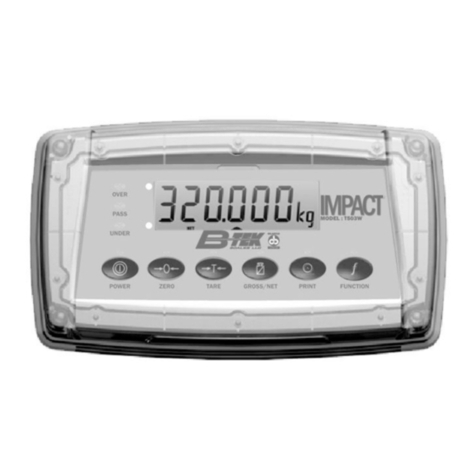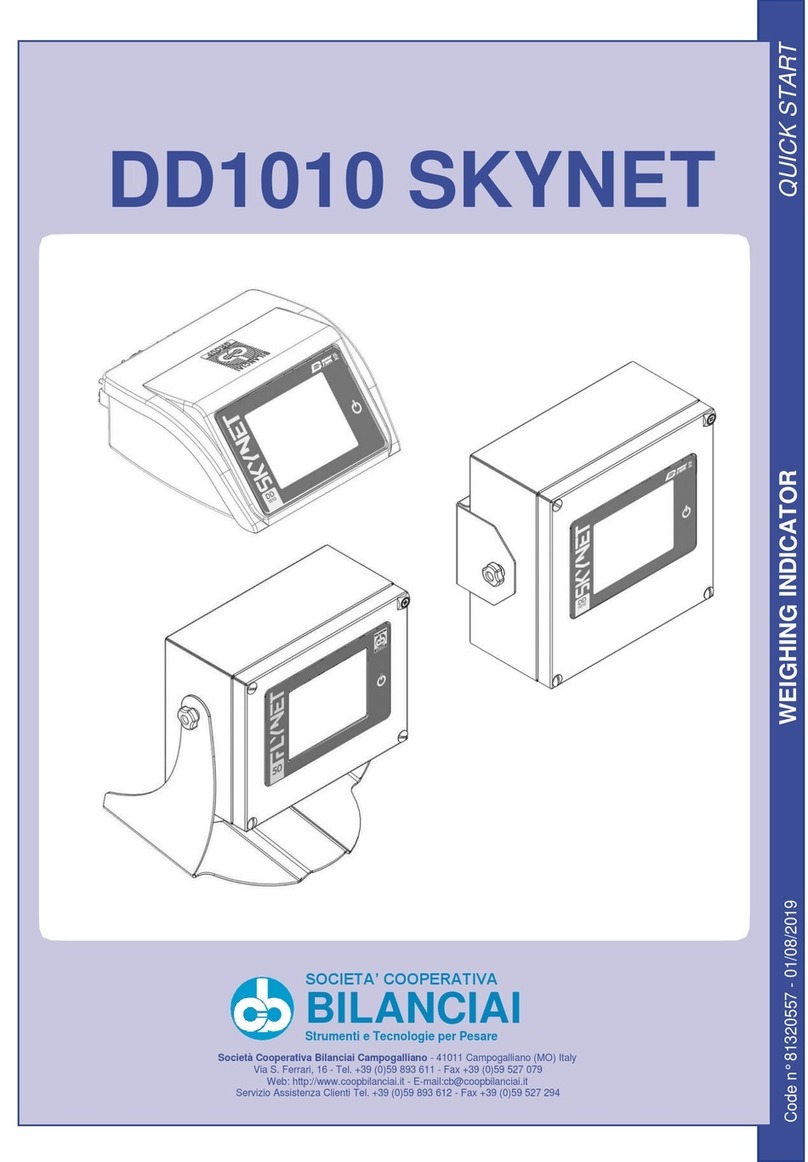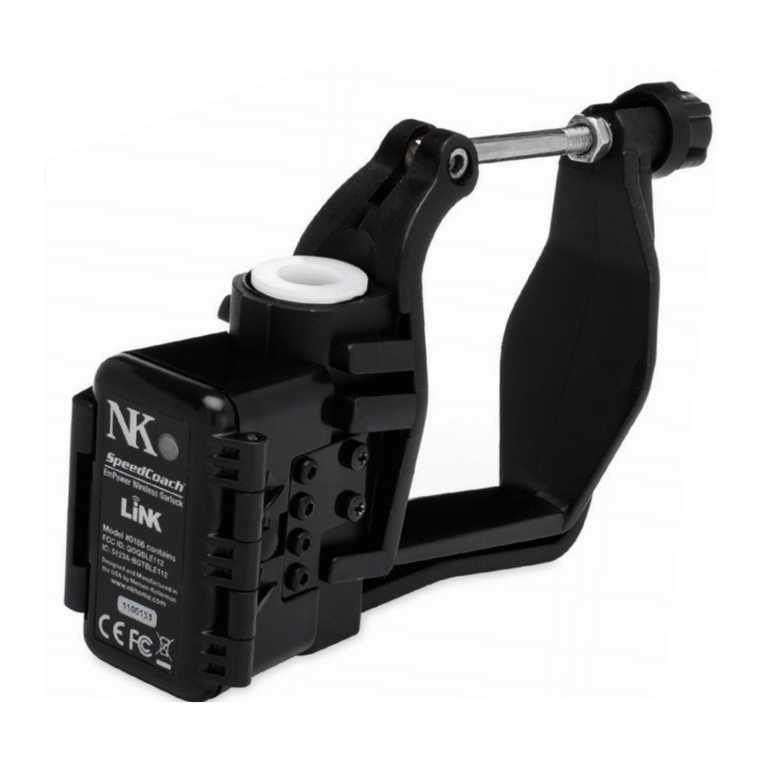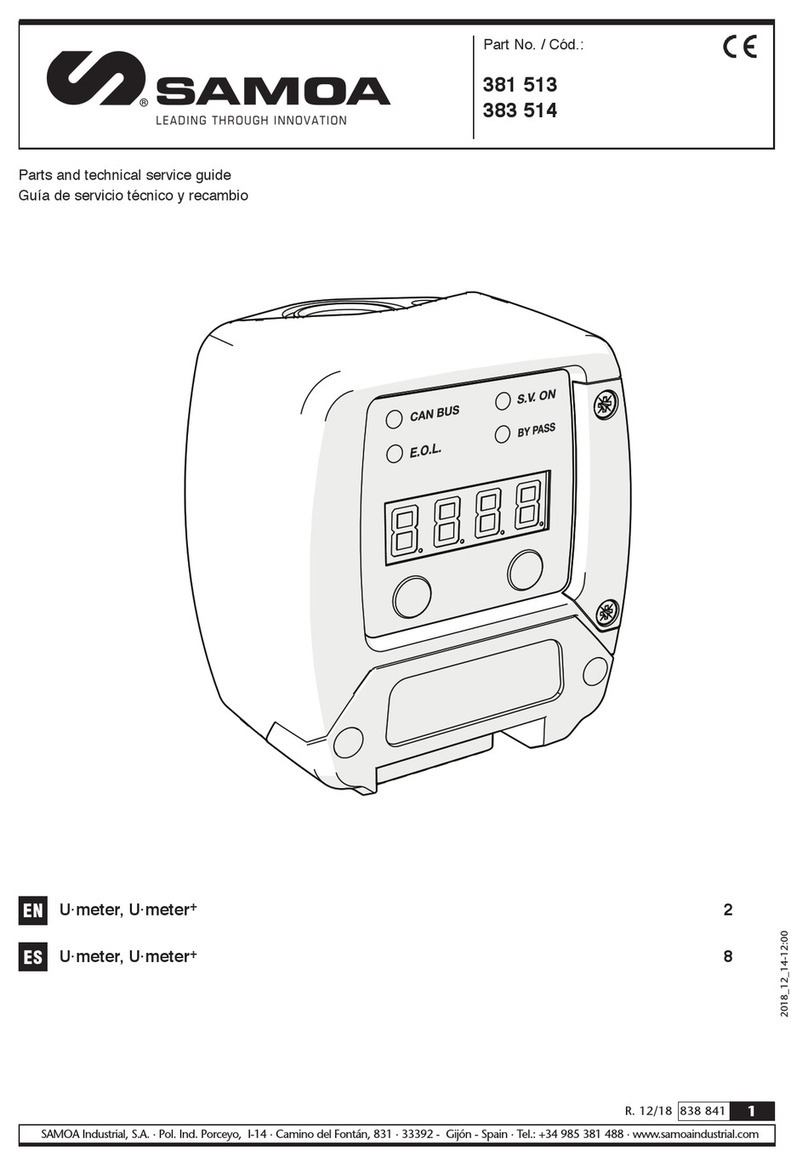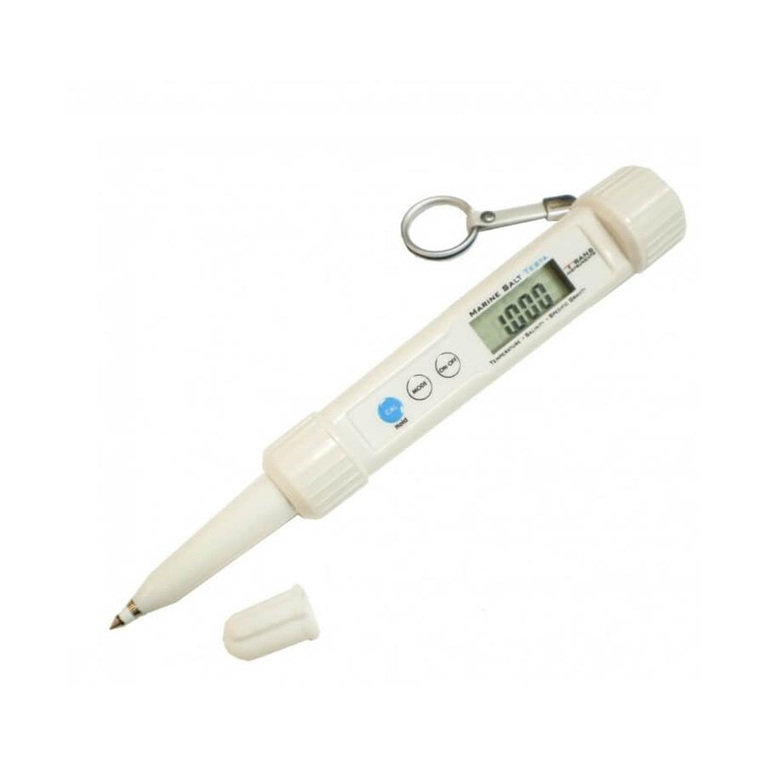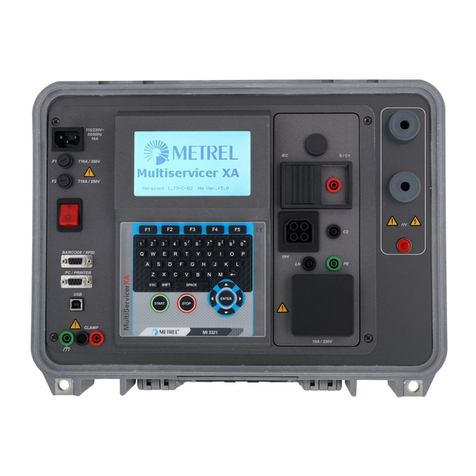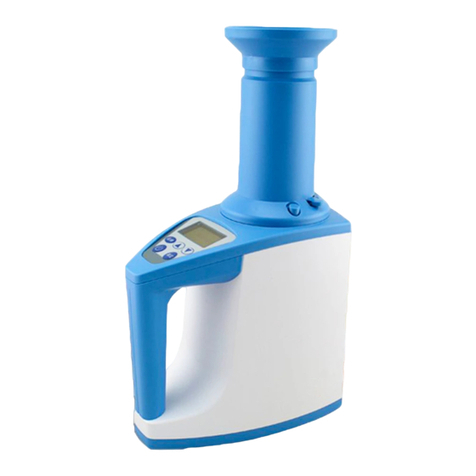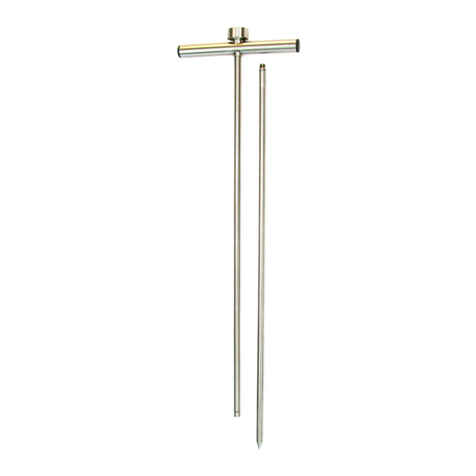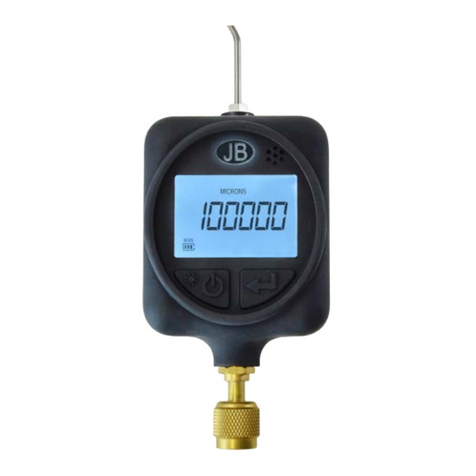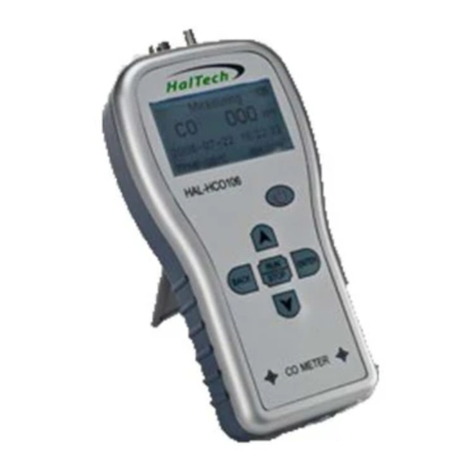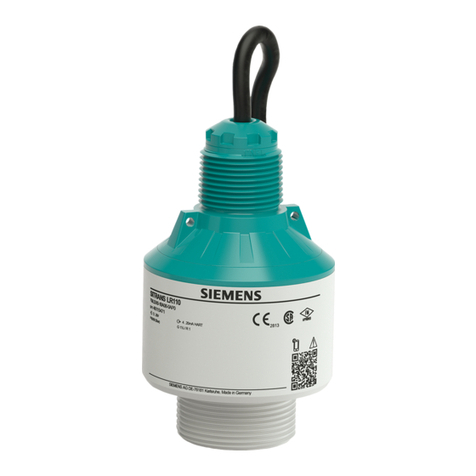Bilanciai B-TEK Scales T503W User manual


Copyright
All Rights Reserved. No part of this document may be
copied, reproduced, republished, uploaded, posted,
transmitted, distributed, stored in or introduced into a
retrieval system in any form, or by any means (electronic,
mechanical, photocopying, recording or otherwise)
whatsoever without prior written permission of
the distributor.
Disclaimer
The distributor reserves the right to make changes
to the products contained in this manual in order
to improve design, performance or reliability.
The information in this manual is believed to be accurate in
all respects at the time of publication, but is subject to
change without notice. The distributor assumes no
responsibility for any errors or omissions and disclaims
responsibility for any consequences resulting from the use
of the information provided herein.
SPECIAL NOTE
Trade Use of the Instrument
This manual may occasionally make reference to
Trade Use settings of the instrument.
Some individual settings may not be legal for trade use.
Please check regulations with the appropriate
Weights and Measures Authority.

Operator Manual Rev 1.21
003X-607-121 Page 1
Table of Contents
1. INTRODUCTION.............................................................2
1.1. Approvals ..............................................................2
1.2. Features ................................................................2
1.3. Manuals.................................................................2
2. SAFETY ..........................................................................3
2.1. Operating Environment .........................................3
2.2. Electrical Safety.....................................................3
2.3. Cleaning ................................................................3
3. BASIC OPERATION.......................................................4
3.1. User Interface Display and Controls .....................4
3.2. Operation Keys......................................................5
3.3. Stability Considerations.........................................7
3.4. Annunciators .........................................................8
4. BASIC WEIGHING..........................................................9
4.1. Normal Weighing...................................................9
4.2. Using Tare.............................................................9
5. SPECIAL FUNCTIONS.................................................10
5.1. Testing the Display..............................................10
5.2. Counting ..............................................................10
5.3. Units Switching (kg / lb).......................................10
5.4. Hold .....................................................................11
5.5. Peak Hold............................................................11
5.6. Live Weighing......................................................12
5.7. Showing Totals....................................................13
5.8. High Resolution (K304, K306).............................13
5.9. High Resolution (K303) .......................................14
5.10. Automatic Tare ....................................................14
5.11. Check Weigh .......................................................15
6. ERROR MESSAGES....................................................16
6.1. Weighing Errors...................................................16
6.2. Setup and Calibration Errors...............................17
6.3. Diagnostic Errors.................................................18

Operator Manual Rev 1.21
Page 2 003X-607-121
1.Introduction
This instrument is an IP69K rated precision digital indicator
using the latest Sigma-Delta A/D technology to ensure fast
and accurate weight readings.
1.1. Approvals
•C-tick approved and CE approved.
1.1.1. Trade versions
•NSC approval (4000 divisions at 0.8µV/division).
•NMI approval (4000 divisions at 0.8µV/division).
•NTEP approval (10000 divisions at 0.8µV/division).
1.2. Features
•Zero and Tare functionality as well as battery backed
clock/calendar, special function key (for counting, live
weight averaging, peak-hold, etc.).
1.3. Manuals
For more information on this instrument refer to the
Reference Manual, Quick Start Manual or
Communications Manual.

Operator Manual Rev 1.21
003X-607-121 Page 3
2.Safety
2.1. Operating Environment
•Operating Temperature: –10 to 50°C
•Humidity: 100%
•Operating Voltage: Shown on Rear Label
•IP69K
2.2. Electrical Safety
•For your protection all mains electrical hardware must be
rated to the environmental conditions of use.
•Pluggable equipment must be installed near an easily
accessible power socket outlet.
•To avoid the possibility of electric shock or damage to the
instrument, always switch off or isolate the instrument
from the power supply before maintenance is carried out.
2.3. Cleaning
•The unit has been designed for high-pressure, high
temperature (80°C) wash-down environments. However
long periods of focused pressure at a close range will
damage the casing. Casing is chemical resistant.

Operator Manual Rev 1.21
Page 4 003X-607-121
3.Basic Operation
3.1. User Interface Display and Controls

Operator Manual Rev 1.21
003X-607-121 Page 5
3.2. Operation Keys
Key Description
POWER: The <POWER> key is used to turn the
instrument on and off.
•To initially turn the instrument ON: Press
and hold the <POWER> key until the display
starts up.
•To turn the instrument OFF: Press and hold
the <POWER> key for three seconds. The
instrument will display OFF followed by the
three-second countdown.
Note: If the <POWER> key has been locked,
the instrument cannot be turned off from the
front keypad.
•Battery Operation: When using batteries the
backlight may automatically turn off to
conserve power after a short period of
inactivity. Motion on the scale or a short press
of the <POWER> key will turn the backlight on
again.
•Automatic Operation: The <POWER> key
has a memory function associated with it. This
means that the state of the power setting is
remembered even if external power is
interrupted. It is therefore possible to turn the
instrument on in the safe knowledge that it will
operate whenever external power is available
and will not need to be manually turned on
again if the power is interrupted.

Operator Manual Rev 1.21
Page 6 003X-607-121
Key Description
ZERO: The <ZERO> key is used to perform a
Zero adjustment on the scale display when an
empty scale has drifted away from a true zero
reading.
•The Zero adjustment is stored when power is
removed and is re-used when next powered
up.
•Long Press: When the indicator is set to
Industrial mode a long press of the <ZERO>
key will remove any stored zero adjustment.
TARE: The <TARE> key is used to temporarily
set the scale to zero (such as cancelling the
weight of a carton before performing a filling
operation). The display will show the Net weight
and the Net annunciator will be lit.
•The <TARE> key can operate in all modes
(ie. Industrial, OIML and NTEP).
•The weight tared is deducted from the allowable
range of the scale, reducing the maximum
weight that can be displayed.
•The Tare adjustment is stored when power is
removed and is re-used when next powered
up.
GROSS/NET: The <GROSS/NET> key toggles
the weight display between the Gross weight and
the Net weight (provided that a Tare has
previously been acquired using the <TARE> key).

Operator Manual Rev 1.21
003X-607-121 Page 7
Key Description
PRINT: The <PRINT> key will trigger an output of
the current weight reading if a printer or computer
has been attached to the instrument and the
manual print function has been selected.
•The PRINT prompt is displayed while waiting
for the printer to accept data.
•If the printer is offline the PRINT prompt will
remain for a maximum of 10 seconds before
the operation is cancelled.
•Each weight printed is automatically added to
an internal total weight. Note: For K307,
accumulation mode must be enabled for this to
occur.
•Long Press: A long press of the <PRINT> key
will print the total. The total weight is then
cleared automatically.
FUNCTION: The <FUNCTION> key is program–
mable to suit customer requirements. A label
identifying the special function will be attached.
Refer to Special Function page 10 for details of
the available functions.
•Long Press: A long press of the <FUNCTION>
key may be used for certain functions
depending on the primary function of the key.
3.3. Stability Considerations
Once a <ZERO>, <TARE> or <PRINT> key is pressed the
unit waits for a stable valid reading before performing the
associated operation. If the weight readings remain
unstable or invalid due to some diagnostic error for longer
than 10 seconds, the operation is cancelled and the
STABLE ERROR message is displayed.

Operator Manual Rev 1.21
Page 8 003X-607-121
3.4. Annunciators
Symbol Name Description
ZERO Visible when the gross reading is
within ±¼ of a division of true zero.
NET Visible when the displayed reading
represents Net weight.
MOTION Visible when the displayed reading
is not stable.
OVER
Visible when check weighing is
enabled and the weight is above
the target weight.
UNDER
Visible when check weighing is
enabled and the weight is below the
target weight.
PASS
Visible when check weighing is
enabled and the weight is between
the target weights.
1 RANGE 1 Visible when dual range is enabled
and range 1 is active. (K306 only.)
2 RANGE 2 Visible when dual range is enabled
and range 2 is active. (K306 only.)
ZERO
BAND
Visible when the displayed weight is
within the zero 'dead' band setting.
(The zero band symbol shows near
the top right corner of the display.)
HOLD Visible when the displayed reading
is held.
LOW
BATTERY
Visible when battery voltage is too
low and batteries need replacing or
recharging. (The low battery
symbol shows in the top right
corner of the display.)

Operator Manual Rev 1.21
003X-607-121 Page 9
4.Basic Weighing
4.1. Normal Weighing
•Ensure instrument is On and Zero annunciator is lit.
•Place your item on the weigh platform.
•Read the weight display.
4.2. Using Tare
•The indicator displays zero with Zero annunciator lit.
•Place the container on the weigh platform.
•Press the <TARE> key.
•The indicator will show the displayed zero weight and
the Net annunciator will be lit.
•Fill the container to the required weight.
•Press the <GROSS/NET> key to toggle
between the Net weight and the Gross (total)
weight.

Operator Manual Rev 1.21
Page 10 003X-607-121
5.Special Functions
5.1. Testing the Display
•Press the <TEST> key to clear the display then
show all segments of the display then clear the
display again before returning to normal
operation.
5.2. Counting
•Place the container on the weigh platform and
press <TARE> if required.
•Place the sample pieces to be counted on the weigh
platform.
•Press and hold the <COUNT> key for two
seconds. The default number of pieces in
the sample will be displayed.
•Use the <GROSS/NET> and <PRINT>
keys to alter the number of pieces.
and
•Press <COUNT>. The current sample will be
stored against the entered pieces. The letter p
(for pieces) displays when in counts display.
•Press the <COUNT> key to toggle between the weight
display and the counts display.
•If printing is enabled the sample quantity and weight will
be printed.
5.3. Units Switching (kg / lb)
•Press the <UNITS> key to switch the display
between kilograms and pounds.
•Printing and serial communications will use the units
displayed (either lb or kg).

Operator Manual Rev 1.21
003X-607-121 Page 11
5.4. Hold
•Press the <HOLD> key to hold the displayed
weight at its current weight.
•The Hold annunciator will be lit.
•Press the <HOLD> key again to release the
weight reading and return the display to normal
weighing.
•All printouts that print the displayed weight will use the
held weight reading if it is currently being displayed. Note:
K307 will not print while a weight is held.
5.5. Peak Hold
•Press the <PEAK> key to show the largest
absolute weight, either positive or negative (eg. -
30 is larger than 25). The instrument compares
the current weight reading with the stored peak
and updates the peak reading whenever a larger
weight is detected.
•The Hold annunciator will be lit.
•Press the <PEAK> key to toggle between the
current weight and the peak weight.
•When displaying the peak weight the Hold
annunciator will be lit.
•When displaying the peak weight, press and hold
the <PEAK> key for two seconds to clear the
peak value and reset back to 0 (zero).
•All printouts that print the displayed weight will use the
held weight reading if it is currently being displayed. Note:
K307 will not print while a weight is held.

Operator Manual Rev 1.21
Page 12 003X-607-121
5.6. Live Weighing
•Press and hold the <LIVE WT> key to switch
between normal weighing and live weight
mode. The display will briefly show NORMAL
or LIVE.WT.
•Note: During normal weighing, this key
operates exactly like a manual <HOLD> key.
•When in Live-Weight mode and while the Net weight is
within the zero 'dead' band, the instrument shows the
current weight.
•Press the <TARE> or <ZERO> key
to clear any residual weight and
return the scale to the zero state.
or
•Move the animal on to the weigh platform.
•Once the weight moves outside the zero 'dead' band the
instrument begins to calculate a long-term average that
compensates for any movement in the mass. The
instrument flashes the Hold annunciator and shows the
current average value.
•The Hold annunciator is steady when the final sample
weight is shown on the display.
•Press the <LIVE.WT> key to force the sample
to be recalculated.
•Once the animal is removed, the instrument
automatically clears the previous reading ready for the
next animal.

Operator Manual Rev 1.21
003X-607-121 Page 13
5.7. Showing Totals
•The <PRINT> key is used not only to print the
current weight but also to add that weight to
the current total.
•When the <TOTAL> key is pressed, the
indicator displays COUNT followed by the
number of items in the total.
•After this the indicator displays TOTAL followed by the
current total weight.
•If the total weight is too large to display in six digits, the
weight is shown in two sections labelled with the upper
six digits displayed before the lower six digits.
•Press and hold the <PRINT> key to cause the
total accumulated weight to be printed and
then cleared.
5.8. High Resolution (K304, K306)
•When the <HI RES> key is pressed, the
indicator shows a high resolution (x 10) on the
display for a period of 5 seconds before
reverting to the normal weight display.
•While the high resolution is displayed the units
annunciator flashes.
•Printing is inhibited while the high resolution is
displayed.

Operator Manual Rev 1.21
Page 14 003X-607-121
5.9. High Resolution (K303)
•When the <HI RES> key is pressed, the
indicator shows a high resolution (x 10) on the
display.
•While the high resolution is displayed the units
annunciator flashes.
•Printing is inhibited while the high resolution is
displayed.
5.10. Automatic Tare
•The <A.TARE> key is pressed to activate and
deactivate the automatic tare mode.
•Press and hold the <A.TARE> key for two
seconds. The automatic tare threshold weight
will be displayed.
•Use the <GROSS/NET> and
<PRINT> keys to alter the
threshold weight.
and
•Press <A.TARE> . The current threshold
weight will be stored.
•When the automatic tare is active the instrument will be
tared whenever the weight is above the threshold
weight. The tare weight is reset to zero when the gross
weight is motionless within the zero “dead” band.

Operator Manual Rev 1.21
003X-607-121 Page 15
5.11. Check Weigh
•When the <Check.W> key is pressed the
display will briefly show each of the following:
•OVER
•The target weight for over.
•UNDER
•The target weight for under.
•Press and hold the <Check.W > key for two
seconds OVER will be displayed followed by
the over target weight for editing.
•Use the <GROSS/NET> and
<PRINT> keys to alter the over
target weight.
and
•Press <Check.W >. The over target weight
will be stored. UNDER will be displayed
followed by the under weight for editing.
•Use the <GROSS/NET> and
<PRINT> keys to alter the
under target weight.
and
•Press <Check.W >. The setpoint 2 target
weight will be stored. And the display will
return to normal.
•Note: For the setpoint thresholds to have any effect the
relivant setpoint options need to be selected in the
setpoint menu.

Operator Manual Rev 1.21
Page 16 003X-607-121
6.Error Messages
6.1. Weighing Errors
Error Description Resolution
(U - - - - -) The weight is below
the minimum allowable
weight reading.
Increase the weight or
decrease the minimum
allowable weight
reading.
(O - - - - -) The weight is above
the maximum
allowable weight
reading.
Warning - overloading
may damage
mechanical scale
elements.
Check the condition of
load cell connections.
Check for damaged
load cell.
(ZERO)
(ERROR)
The weight reading is
beyond the limit set for
Zero operation. The
operation of the
<ZERO> key is limited
in the setup during
installation. The
indicator cannot be
Zeroed at this weight.
Increase the Zero
Range (OPTION:
Z.RANGE) or use the
<TARE> key instead.
(STABLE)
(ERROR)
Scale motion has
prevented a <ZERO>,
<TARE> or <PRINT>
operation from
occurring on
command.
Try the operation again
once the scale is
stable.

Operator Manual Rev 1.21
003X-607-121 Page 17
6.2. Setup and Calibration Errors
Error Description Resolution
The instrument may be in
Safe Setup and an item that
needs Full Setup has been
selected for editing.
Access Full Setup to edit
the item.
(ENTRY)
(DENIED)
When accessing setup,
more than three attempts
have been made with the
incorrect passcode.
Turn the instrument off.
When the instrument is
turned back on, enter the
correct passcode to access
setup.
(LIN.PT)
(LO)
An attempt has been made
to place a linearisation point
below zero.
Incorrect linearisation point
entered (must be between
zero and full scale).
(PT.TOO)
(CLOSE)
An attempt has been made
to place a calibration point
too close to an existing
calibration point.
Re-enter the calibration
point. Points must be
spaced by at least 2% of
full scale from each other.
(RES)
(LO)
The scale build is configured
for less than 100
graduations.
Check the resolution
(count-by) and capacity
settings.
(RES)
(HIGH)
The scale build is configured
for more than 30,000
graduations.
(K307: 60,000 graduations)
Check the resolution
(count-by) and capacity
settings.
(SPAN)
(LO)
The load cell signal range
(span) is too small for these
settings.
Incorrect span weight
entered (must be between
zero and full scale). Scale
wiring incorrect. Wrong
load cell capacity (too
large). Wrong or no
calibration weight added to
scale.
(SPAN)
(HI)
The load cell signal range
(span) is too large for these
settings.
Incorrect span weight
entered (must be between
zero and full scale). Scale
wiring incorrect. Load cell
capacity too small for
application.
(ZERO)
(LO)
An attempt has been made
to calibrate zero below
-2mV/V.
Scale wiring incorrect.
(ZERO)
(HI)
An attempt has been made
to calibrate zero above
+2mV/V.
Remove all weight from
scale. Scale wiring
incorrect.

Operator Manual Rev 1.21
Page 18 003X-607-121
6.3. Diagnostic Errors
•Check: Service personnel can check this item on site.
•Return for Service: The instrument must be returned to the
manufacturer for factory service.
Error Description Resolution
(E0001) The power supply voltage is too
low.
Check supply
(E0002) The power supply voltage is too
high.
Check scale /
cables
(E0010) The temperature is outside of
allowable limits.
Check location
(E0020) Scale build is incorrect. The
number of graduations has been
set too low or too high.
Fix up scale build
(E0100) The digital setup information has
been lost.
Re-enter setup
(E0200) The calibration information has
been lost.
Re-calibrate
(E0300) All setup information has been
lost
Enter setup and
calibrate
(E0400) The factory information has been
lost.
Return for Service
(E0800) The EEPROM memory storage
chip has failed
Return for Service
(E2000) ADC Out of Range Error. This
may be caused from a broken
load cell cable.
Check
BUILD:CABLE
setting. Check load
cell cable, wiring,
etc.
(E4000) The battery backed RAM data
has lost data.
Re-enter setup
(E8000) The FLASH program memory is
incorrect
Return for Service
The Etype error messages are additive. For example if instrument is
running off batteries and the temperature drops, the battery voltage may
be too low. The resulting error messages will be E0011 (0001 + 0010).
The numbers add in hexadecimal as follows:
1 - 2 - 3 - 4 - 5 - 6 - 7 - 8 - 9 - A - B - C - D - E - F
(For example, 2 + 4 = 6, or 4 + 8 = C
Other manuals for B-TEK Scales T503W
1
Table of contents
Other Bilanciai Measuring Instrument manuals
Popular Measuring Instrument manuals by other brands
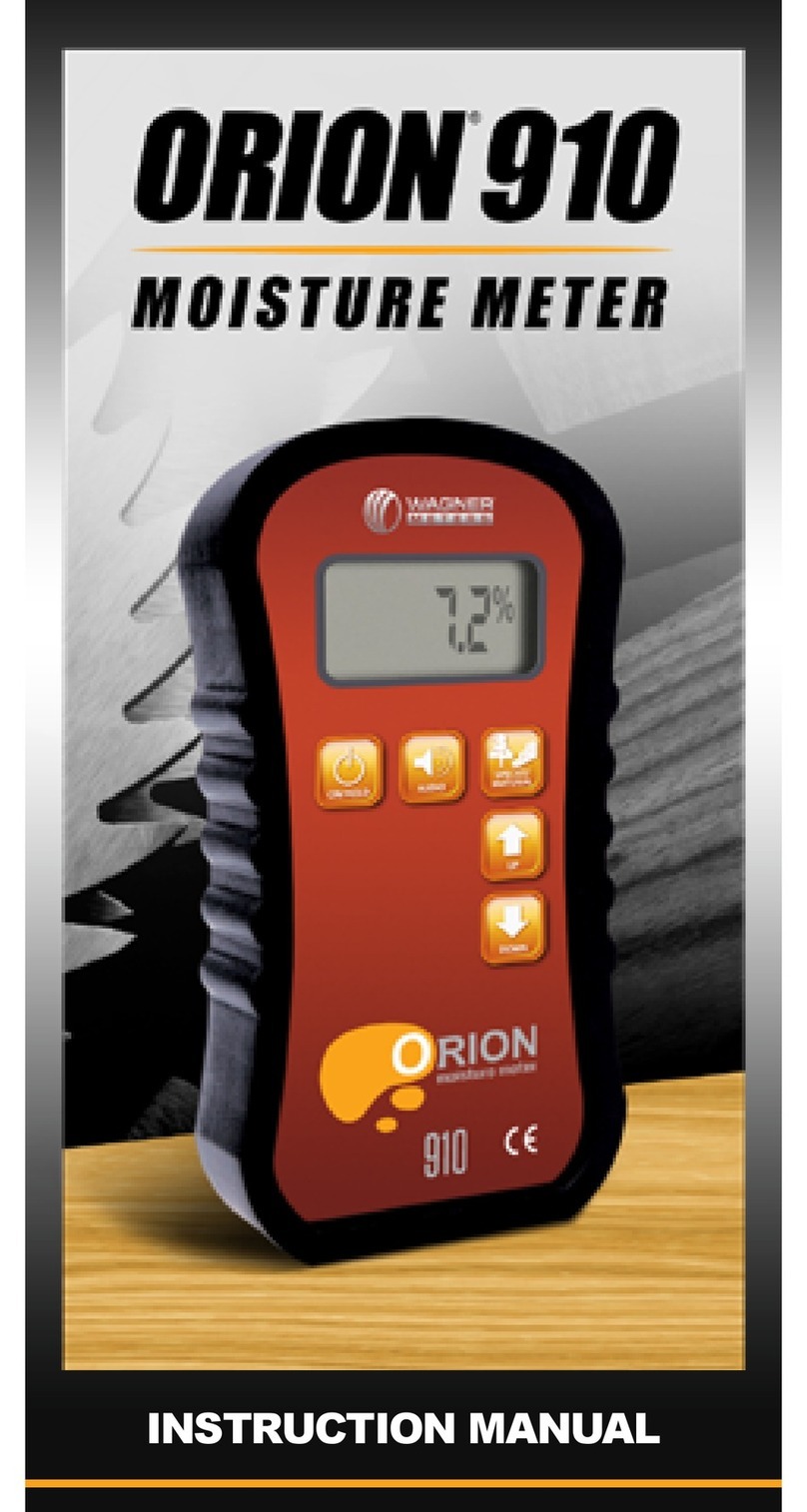
Wagner Meters
Wagner Meters Orion 910 instruction manual
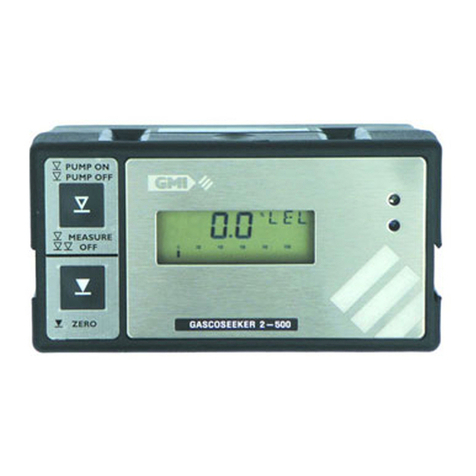
Gas Measurement Instruments
Gas Measurement Instruments Gascoseeker 2-500 User handbook

Leviton
Leviton 4000 Series installation guide

Fluke
Fluke 1742 Manual supplement
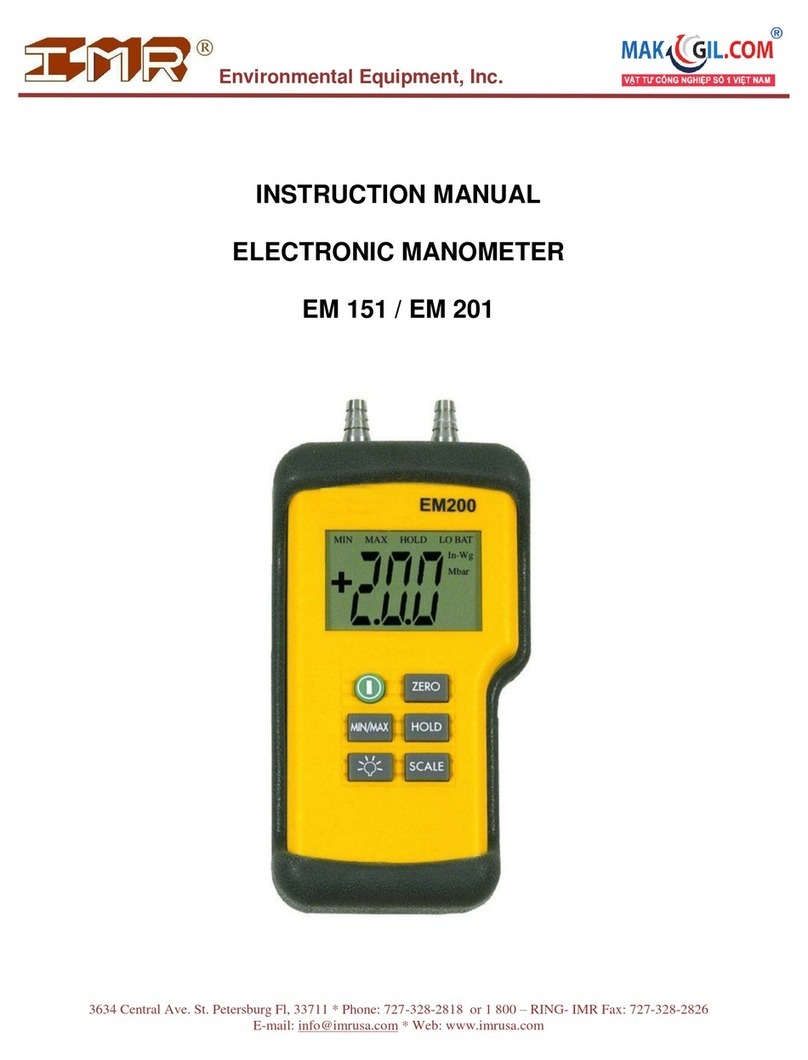
IMR
IMR EM 201 instruction manual

Tractel
Tractel Handifor 20 Installation, operating and maintenance manual
